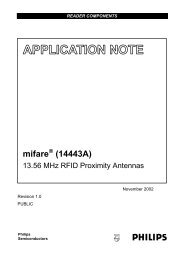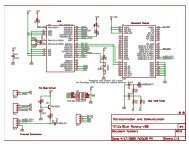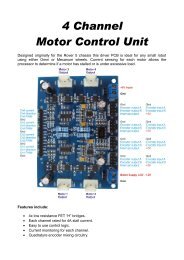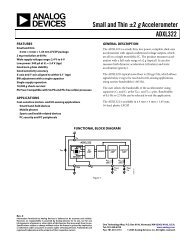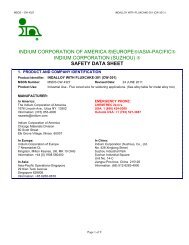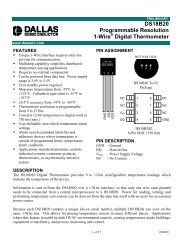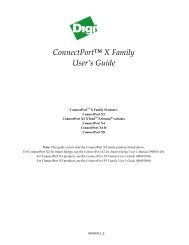u-blox 6
u-blox 6
u-blox 6
Create successful ePaper yourself
Turn your PDF publications into a flip-book with our unique Google optimized e-Paper software.
13.7.3.2 Changing ALP files<br />
The server function periodically attempts to receive new ALP data from an upstream server, as the result of an<br />
HTTP request or other means of file transfer.<br />
In case a new file becomes available, the server shall indicate this to the Client. This is the function of the<br />
fileId field.<br />
The server should number ALP files it serves arbitrarily. The only requirement is that the fileId actually is<br />
changed when a new file is being served, and that it does not change as long as the same file is being<br />
changed.<br />
If the client, as a result of a client request, receives a fileId different from the one in earlier requests' replies,<br />
it will reinitialize the ALP engine and request data anew.<br />
Further, if the client attempts to send data to the server, using the ALPSRV-CLI method, it indicates, which<br />
fileId needs to be written. The server shall ignore that request in case the fileId numbers do not match.<br />
13.7.3.3 Sample Code<br />
u-<strong>blox</strong> makes available sample code, written in C language, showing a server implementation, serving ALP data<br />
from its file system to a client. Please contact your nearest u-<strong>blox</strong> Field Application Engineer to receive a copy.<br />
13.8 AssistNow Autonomous<br />
This functionality is only supported by u-<strong>blox</strong> 6 Firmware 7.01 and above.<br />
13.8.1 Introduction<br />
The A-GPS scenarios covered by AssistNow Online and AssistNow Offline require an online connection and a<br />
host that can use this connection to download aiding data and provide this to the receiver when required.<br />
The AssistNow Autonomous feature provides a functionality similar to A-GPS without the need for a host and a<br />
connection. Based on a broadcast ephemeris downloaded from the satellite (or obtained by A-GPS) the receiver<br />
can autonomously (i.e. without any host interaction or online connection) generate an accurate satellite orbit<br />
representation («AssistNow Autonomous data») that is usable for navigation much longer than the underlying<br />
broadcast ephemeris was intended for. This makes downloading new ephemeris or aiding data for the first fix<br />
unnecessary for subsequent start-ups of the receiver.<br />
The AssistNow Autonomous feature is disabled by default.<br />
13.8.2 Concept<br />
The figure below illustrates the AssistNow Autonomous concept in a graphical way. Note that the figure is a<br />
qualitative illustration and is not to scale.<br />
• A broadcast ephemeris downloaded from the satellite is a precise representation of a part (nominally four<br />
hours) of the satellite's true orbit (trajectory). It is not usable for positioning beyond this validity period<br />
because it diverges dramatically from the true orbit afterwards.<br />
• The AssistNow Autonomous orbit is an extension of a broadcast ephemeris. It provides a long-term orbit for<br />
the satellite for several revolutions. Although this orbit is not perfectly precise it is a sufficiently accurate<br />
representation of the true orbit to be used for navigation.<br />
• The AssistNow Autonomous data is automatically and autonomously generated from downloaded (or<br />
assisted) ephemerides. Data for approximately twenty satellites is stored automatically in the on-chip battery<br />
backup RAM. Optionally, data for the full constellation (32 satellites) can be stored in external flash memory<br />
(if available) or on the host.<br />
GPS.G6-SW-10018-A Public Release Page 38 of 201



